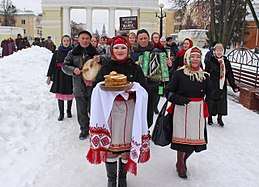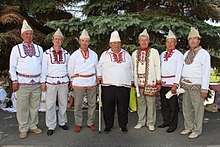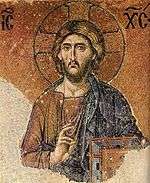Mari people
The Mari (Mari: мари, Russian: марийцы) are a Finno-Ugric ethnic group, who have traditionally lived along the Volga and Kama rivers in Russia. Almost half of Maris today live in the Mari El republic, with significant populations in the Bashkortostan and Tatarstan republics. In the past, the Mari have also been known as the Cheremisa or the Cheremis people in Russian and the Çirmeş in Tatar.
 Mari people in Yoshkar-Ola | |
| Total population | |
|---|---|
| c. 600,000 | |
| Regions with significant populations | |
* | 547,605 (2010) *290,863(2010)[1] |
| 4,416 (2009)[2] | |
| 4,130 (2001)[3] | |
| 416 (2009)[4] | |
| 234 (2019)[5] | |
| 241 (2011)[6] | |
| Languages | |
| Mari, Russian | |
| Religion | |
| Predominantly Russian Orthodox Christianity and Mari Native Religion | |
| Related ethnic groups | |
| Other Finno-Ugric peoples | |
History
Soviet Union
During the Soviet Era, the Mari Section was set up under the auspices of Narkomnats, the Peoples Commissariat for nationalities. Its task was to facilitate the close union of the Mari people with other people, to abolish anti-Russian mistrust and to raise the "class consciousness" of Mari workers. In practice this involved facilitating grain requisitions by the Soviet state, the recruitment of soldiers for the Red Army and the implementation of Bolshevik control of the society.[7]
During the Soviet Era, large numbers of ethnic Russians were moved into traditionally Mari lands, significantly changing the demographics of the region, and making the Mari a minority in many parts of their homeland. Mari people were generally disempowered by these changes. Furthermore, Bolshevik policies officially aimed at combating undue influence of nationalism in a multi-nation union, resulted in the murder of leading Mari figures, such as Sergei Čavajn and Olyk Ipai and other teachers, scientists, artists, as well as religious and community leaders.[8][9]
Russian Federation
Following the collapse of the Soviet Union, the newly created republic of Mari El saw a revival of Mari culture and language. However, following the appointment of Leonid Markelov as Head of the republic in 2001, the government of Mari El has pursued a policy of intense Russification in the region. According to Vasily Pekteyev of the Mari National Theater in Yoshkar-Ola, "[Markelov] hated the Mari people". He noted that the Mari language is no longer taught in villages or schools and that the republic of Mari El "has already ceased to be an ethnic republic in anything but name. We are just another oblast."[10] In 2005, the European Commission expressed its concern over reports of repression against ethnic Mari opposition figures, journalists, and government officials that promoted Mari culture and opposed Markelov's reappointment as head of the republic that year.[11]
Ethnic groups
The Mari people consists of four different groups: the Meadow Mari, who live along the left bank of the Volga, the Hill (Mountain) Mari, who live along the right bank of the Volga, the Northwestern Mari, who live in Kirov and Nizhny Novgorod Oblasts, and Eastern Mari, who live in the Bashkortostan, Tatarstan, Udmurtia republics and Perm Krai and Sverdlovsk Oblast. In the 2002 Russian census, 604,298 people identified themselves as "Mari," with 18,515 of those specifying that they were Mountain Mari and 56,119 as Eastern Mari. Almost 60% of Mari lived in rural areas.[12]
Language

The Mari have their own language, also called Mari, which is a member of the Uralic language family. It is written with a modified version of the Cyrillic alphabet. Linguists today distinguish four different dialects, which are not all mutually intelligible: Hill Mari (мары йӹлмӹ), concentrated mainly along the right Volga bank; Meadow Mari (марий йылме), spoken in the lowland regions of the Kokshaga and Volga rivers, which includes the city of Yoshkar-Ola; Eastern Mari, spoken east of the Vyatka River; and Northwestern Mari (маре йӹлмӹ) in the South-West of Kirov Oblast and North-East of Nizhny Novgorod Oblast.
In the 2002 census, 451,033 people stated that they spoke the Mari language.
Religion


Maris have traditionally practiced a pagan faith that closely connected the individual with nature. According to their beliefs, nature exerts a magical influence over people. They relate to it as a sacred, powerful, and living being outside of which man cannot exist. Nature serves as a source of absolute good who always helps man as long as he does not harm or oppose it.[13]
The Mari native religion also possesses a pantheon of gods who reside in the heavens, the most important of whom is known as the Great White God (Ош Кугу Юмо, Osh Kugu Yumo). Other lesser gods include the god of fire (Тул Юмо, Tul Yumo) and the god of wind (Мардеж Юмо, Mardezh Yumo).
The Mari also believe in a number of half-men, half-gods (керемет, keremet) who live on earth. The most revered of these is Chumbulat (Чумбулат), or Chumbylat (Чумбылат), a renowned leader and warrior.[14]
Christianity was adopted by the Mari in the 16th century after their territory was incorporated into the Russian Empire during the reign of Ivan IV "the Terrible". Adoption of Christianity was not universal, however, and many Mari today still practice Paganism in syncretic forms, or purer forms adhering to organized Neopagan Mari Traditional Religion organizations. Most Mari today are members of the Russian Orthodox Church, Pagans though constitute a significant minority of 25 to 40% of the population.
Genetics
Osteopetrosis affects 1 newborn out of every 20,000 to 250,000[15] worldwide, but the odds are much higher in the Russian region of Mari El with 1 of every 14,000 newborns affected.
See also
- Mari language
- Mari-Udmurt War
References
- Official site of the Russian Census of 2010. Information materials about the final results of the Russian Census of 2010. (in Russian)
- Kazakh Census of 2009. Ethnic composition of the population Archived 2011-07-23 at the Wayback Machine. (in Russian)
- State statistics committee of Ukraine – Ethnic composition of population, 2001 census (in Ukrainian)
- Ethnic composition of Belarus. Census of 2009. (in Russian)
- Population distribution of Latvia by ethnic composition and citizenship as of 01.01.2019.. (in Latvian)
- RL0428: Rahvastik rahvuse, soo ja elukoha järgi, 31. detsember 2011 (in Estonian)
- The Sorcerer as Apprentice: Stalin as Commissar of nationalities, 1917–1924, by Stephen Blank, Greenwood Press, London 1994 ISBN 978-0-313-28683-4
- http://library.ndsu.edu/grhc/articles/magazines/german/vadw_6_2006_1.html
- https://www.youtube.com/watch?v=S7irF6aMUZ8
- Coalson, Robert; Lyubimov, Dmitry; Alpaut, Ramazan (2018-06-20). "A Common Language: Russia's 'Ethnic' Republics See Language Bill As Existential Threat". Radio Free Europe/Radio Liberty. Retrieved 2018-06-21.
- Lobjakas, Ahto (2005-03-07). "European Commission 'Concerned' Over Treatment Of Finno-Ugric Minorities". Radio Free Europe/Radio Liberty. Retrieved 2018-06-21.
- Всероссийская перепись населения 2002 года, "Archived copy". Archived from the original on 2011-07-19. Retrieved 2008-01-16.CS1 maint: archived copy as title (link)
- Шкалина, Галина. "Язычество народа Мари-феномен европейской культуры". "Етносфера".
- Чумбылат – марийский национальный герой (retrieved January 2, 2014) (in Russian)
- ghr.nlm.nih.gov/condition/osteopetrosis
External links
- MariUver, a blog about Mari culture and issues
- The Moscow Times: 'Europe's Last Pagans' Worship in Marii-El Grove
- RT Documentary: Europe's Last Pagans, an English-language video documentary
- Photo story, 2014
- Encyclopaedia of Mari mythology (Russian)
